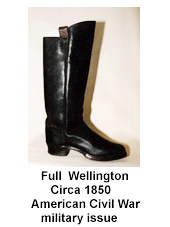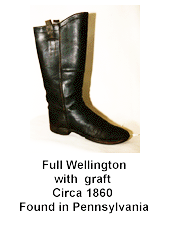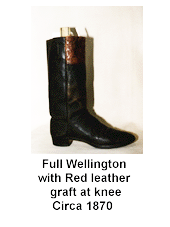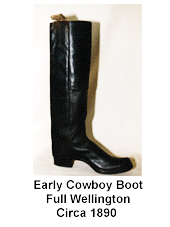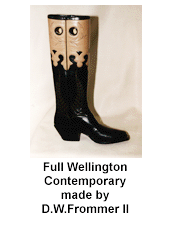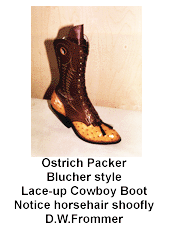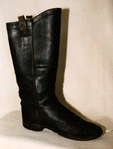
A HISTORY OF THE WESTERN BOOT
SHOE HISTORY
REFLECTIONS ON POLISHED LEATHER
A History of the Western Boot
by D.W.Frommer II
And Gentlemen in England Now A-bed Shall Think Themselves Accursed They Were Not Here,
And Hold Their Manhoods Cheap Whiles Any Speaks That Fought With Us Upon Saint Crispin's Day.
Henry V, Act IV, Scene 3
Although shoemaking has been an established art for at least 3500 years, any review of the history of the cowboy boot must begin somewhere. We could start on the great plains of North America in the latter half of the 19th century; according to some theories we could even start with the conquistadors in the 17th century. But within the trade itself--among shoe and bootmakers--the legends, the traditions, and the history really begin with St. Crispin. St. Crispin is the patron saint of shoemakers. Since medieval times, October 25th has been celebrated as St. Crispins Day and the Shoemaker's Holiday. In the past, boot and shoemakers traditionally closed their shops on this day, in celebration and commemoration. I say commemoration because there is more to the story of St. Crispin than meets the eye.
Actually there are two stories that seem to be the same...one in England, one in France. St. Crispin was born into a wealthy roman family in the third century A.D.. Somewhere fairly early on, he converted to Christianity. Since this was not an approved lifestyle for a noble Roman, legend says that he was disinherited. Forced to fall back upon his own resources, St. Crispin (not yet a saint) became a shoemaker. Although teaching the gospel was his life's work, he made shoes in his spare time--until he was put to death for his beliefs in Soissons, France in 288 A.D.. We know a little more about St. Hugh, the English counterpart to St. Crispin. Born Hugh, son of Arviragus--king of Powisland (modern day Wales), St. Hugh married a Christian princess, Winifred of Flintshire. She quickly converted him to Christianity, with roughly the same results. Thrown into poverty, Hugh became a shoemaker who preached the gospel by day and plied his craft by night. Both he and Winifred were put to death, ostensibly for rabble-rousing, about 300 A.D.. Legend has it that his fellow shoemakers kept constant vigil and consoled him during the time of his internment. After his death, by hanging, his friends pulled his body from the gibbet and dried his bones. These were made into tools for making shoes. For many years, in fact, a shoemaker's tool kit was called St. Hugh's Bones.
A common thread in these stories, and the many others that surround shoemakers, is the theme of nobility . Indeed the heel itself is a mark of nobility. The earliest information we have of the high heel being used for riding, describes invading Mongol tribesmen wearing bright red wooden heels. Mongols were consummate horsemen and their easy victories left a mark on European society. Since owning and caring for a horse requires some wealth and since being horseback places a person physically above the common man, riders and, consequently, high heels became associated with nobility. To this day, we say well-heeled to describe someone who is wealthy or aristocratic.
The Stuart cavaliers--king's men all--that immigrated to America during the Cromwellian Interregnum brought with them their thigh high riding boots...with high heels. Many settled in the south and indeed the bulk of the southern plantation class was descended from cavalier stock; a fact that played a big part in the unfolding of the American Civil War and the pre-eminence of the southern cavalry. Before and after the civil war many southerners emigrated to Texas or went west to escape the devastation of the war. Again their notion of high heels and nobility went with them.
Many people have speculated upon the origins of the cowboy boot, but the Northampton Museum in England has one of the largest collections of historical footwear in the world and in these exhibits can be found the true story of the western boot. Throughout the 17th and 18th century exhibits are examples of riding boots which, as with one particular pair made in approximately 1630, have high tops, pointed toes and 2" stacked heels. During this period of time, boots were made upon straight--lasts that were neither left nor right. Rights and lefts had been common before this era but with the emerging fashion for high heels (some as high as 3") and the difficulty of producing paired lasts at the higher heel height, most footwear was produced on the straight last. Military styles had a great influence on boots during this time although for practical reasons the tops of boots gradually began to come down from the thigh high buckets of the cavaliers.
In 1790 paired lasts were reintroduced mostly as a response to lower heel heights. And as the new century began, boots became very fashionable, even for women. In 1815, Arthur Wellsley, First Duke of Wellington, defeated Napoleon at Waterloo. In the wake of his victory and his ensuing popularity, Wellington boots became THE style. The major difference in these boots from previous styles was that the heels were low cut and the tops were only calf high. At Northampton there is a pair of dress wellingtons made in 1817. They are a four piece boot--vamp, counter cover, front and back tops--with beaded side seams (the same layout as a modern cowboy boot).
The vamps and counter covers are black patent leather, the tops are maroon with an olive top binding and trim...and they have a fancy decorative stitch pattern on the front of the leg. With 1" stacked leather heels and inside canvas pulls they are remarkably like the western boots that later became part of the history of the American frontier. In 1847, S.C. Shive, in America, patented the patterns and crimping board for what we call a Full Wellington--a two piece boot that found wide acceptance among the military, horsemen, and adventurers of the time. By 1868 Wellingtons were almost exclusively an American style, not much seen in a Europe which preferred the Hessian boot.
 From the 1850's to the 1880's, the full wellington was the boot that military officers were issued. And although by regulation, foot soldiers and enlisted men were issued shoes (ankle high lace-ups--predecessors of the packer), the full wellington was preferred and was the boot that went west with the army and the nation.(see photos) During the Civil War, the Quartermaster Corp. requisitioned supplies from many different civilian contractors. The word shoddy derives from this time and refers to a particular kind of wool cloth made from mill sweepings.
From the 1850's to the 1880's, the full wellington was the boot that military officers were issued. And although by regulation, foot soldiers and enlisted men were issued shoes (ankle high lace-ups--predecessors of the packer), the full wellington was preferred and was the boot that went west with the army and the nation.(see photos) During the Civil War, the Quartermaster Corp. requisitioned supplies from many different civilian contractors. The word shoddy derives from this time and refers to a particular kind of wool cloth made from mill sweepings.
This cloth was made into blankets and coats and often fell apart as soon as it got wet. In the same vein, military boot orders were often filled by unscrupulous contractors, as well. This is significant in light of the fact that at the end of the war the federal government had a half million pairs of surplus boots on hand--boots which needed to be disposed of. In the years that followed, troops stationed on the frontier often found that the boots that they were issued fell apart quickly, especially in the severe climate and terrain. Just naturally they turned to nearby civilian makers to replace the defective footwear. This business was to be the foundation of the cowboy boot trade that flourished in the ensuing years. It must be said that during and after the war, the Quartermaster Corp. was deeply involved in testing various designs...from leg heights, to methods of attaching soles, to different types and origins of leather. Many advances in construction and materials were introduced by the military. The leather that was settled upon for construction of the uppers is especially noteworthy. After much experimentation, an oak-tanned Spanish leather which was heavily waxed on the flesh side became the standard. And it was from this waxed calf that most of the early cowboy boots were constructed, as well.
By 1870 the standard boot worn by frontier horsemen was, essentially, a variation of military issue. The Coffeyville pattern, as it was called, had a higher Cuban heel (scooped instead of straight in profile); and the front of the boot, despite being basically a full wellington, was often grafted. Indeed, this grafting or piecing of the front of the boot is almost the distinguishing characteristic of many non-military boots. This is not too surprising given that all boots, whether made for military issue or as bespoke (custom) footwear, were made by civilian makers during this time.
By the 1880's the cowboy boot, as a separate style, was beginning to emerge. Now we begin to see stovepipe tops, star and horseshoe inlays, stitch patterns and high heels. By 1900 the four piece boot had become the dominant form--probably as a response to the difficulty of construction with a full wellington, an emerging standard of fit that was somewhat more precise than heretofore, and the fact that, historically, the four piece wellington had been reserved for wealthier customers. Styles, of course, did change with the times. Many are the variations of color and decoration. Heights of heel and top have come and gone; and subtle regional variations have also emerged, so that today, for an experienced eye, there is a marked difference in the Texas boot and the northern boot and perhaps, even the Great Basin boot. For those familiar with western boots, there are presently four major variations of the historical cowboy boot. There is the four piece--the dress wellington--which, as we have seen, evolved from the full wellington in the 1800's. Of course, there is the full wellington itself, which is still around and being made by a few custom makers, both in historical and contemporary configurations.
Then there is the packer. As was mentioned, the lace-up was common on the American frontier. Enlisted men were less likely to be career men and often mustered out of the service in the west. There are the historical photographs of cowboys sitting on the top rail of the corral watching a hand ride out a bronc. In not a few of these photographs the men wearing lace-ups outnumber the men wearing traditional western boots. Hyer Boot Company, in their 1926 catalogue offers at least three pages of lace-up styles--for the ranch hand . The final and fourth style, which is often called the Hollywood or tejas style, has it s roots in military issue just the same as the wellington, but comes a little later in time. In 1887, the military began to issue a different style of boot. Like an English riding boot, they had a seam running up the back of the boot rather than up the side as in the traditional wellington. And in fact, by 1889, the officers boot looked almost identical to the English style. This pattern remained standard issue until the army abandoned the horse and horse units shortly after the 1st World War. However, this pattern gave rise to a three piece western boot with a one piece top and a seam running up the back of the leg as in the military boot. Because the leg of the boot--the top--presents a large canvas for decorative work, some of the most beautiful and refined work ever done by western bootmakers was applied to this style. All through the 30's and 40's (the Hollywood era) the tejas enjoyed a great popularity. But it is a difficult style of boot to make especially if done as a boot and not as a variation of the shoe. That, combined with a cyclical shift towards more conservative styles, caused the tejas to be relegated to near obscurity.
Like the packer, however, the tejas is enjoying somewhat of a resurgence today although the skilled makers of the past are, for the most part, gone now. And that's an important point, because the history of the western boot is not just a chronology of events; not just some academic tracing of the evolution of costume; nor even a study of those who wore the boots. At it's most salient, it is a story of the makers; of skilled hands and the love of refined techniques.
Ultimately, the history of the western boot is the history of bootmaking. There is an interesting story in that regard that June Swann (one time assistant curator at the museum in Northampton) tells. After the civil war many of the trades--jobs that for centuries had relied upon skilled, highly trained craftsmen--began to be industrialized. Just naturally there was great resistance to the very concept of the factory and wage slavery. Boot and shoemakers were some of the most vociferous in this resistance and their industry was, in fact, one of the last to be converted. During the late 1800's, many prize work competitions were staged to demonstrate that factory workers could not compete with skilled craftsmen. Some of the fanciest and most refined work ever to be done was created for these exhibitions. Ms. Swann tells of coming across boots made in Philadelphia for show that were stitched 64 stitches to the inch. Now just about the finest work that can be done on leather with a modern sewing machine is approximately 30 stitches to the inch. More stitches only tear the leather. Additionally, we know that this work was done by hand. James Devlin says in his book The Guide To The Trade that this work was done with an awl so fine that upon an accidental piercing of his hand, the wound neither hurt nor bled; and that a human hair was used for a needle. And although those working in the trade--the boot and shoemakers--are fewer each year; those who work the bristle and the awl do so under the scrutiny of the ghosts of past masters. You feel them at your shoulder. And every highlight thrown from polished leather carries the reflections of noble tradition; of Genghis Khan and Ulan Bator; of lost kingdoms and Bonnie Prince Charlie; of Nathan Bedford Forrest and Phil Sheridan; of Charles Goodnight and Augustus McCrea; of William S. Hart and Bob Wills; of Lobb; and Leopold; and Luchesse; of the horse...and the land...and the leather...and unquestionably even the reflection of ourselves.
Sources: Dictionary of Leather-Working Tools, c.1700-1950; R.A. Salaman; Macmillan Publishing Co, New York, NY
Shoes; June Swann; B.T. Batsford Ltd, London, England
Boots and Shoes Of The Frontier Soldier; Sidney Brinckerhoff; 1976 Arizona Historical Society.
The Guide To The Trade, The Shoemaker; James Devlin; (London 1839)
Battle Cry Of Freedom; James McPherson; Oxford University Press 1988
Also many thanks to Dan Freeman, Jim Bowman,and the Honourable Cordwainers Company for sharing their knowledge;
And an especial thanks to Dave Viers for the loan of a portion of his collection and his openness.
D.W. Frommer II is the author of Western Bootmaking: An American Tradition--a complete tutorial on making the classic four piece western boot. He is also the author of Western Packers: An American Hybrid--a complete tutorial on the making of western packers--on which this series of articles is based. For those interested in a more graphic format, D.W. also offers a 27 hour video--that's 14 tapes--on making the classic pull-on. Additionally, he offers a three week in-shop course.
For more information, call or write to:
D.W. Frommer II-Bootmaker,
827 NW Birch, Redmond, OR 97756.
541/923-3808--no collect.
E-mail: frommer@bootmaker.com








